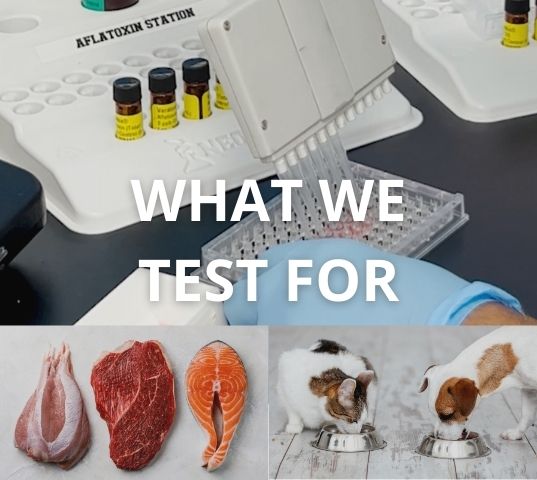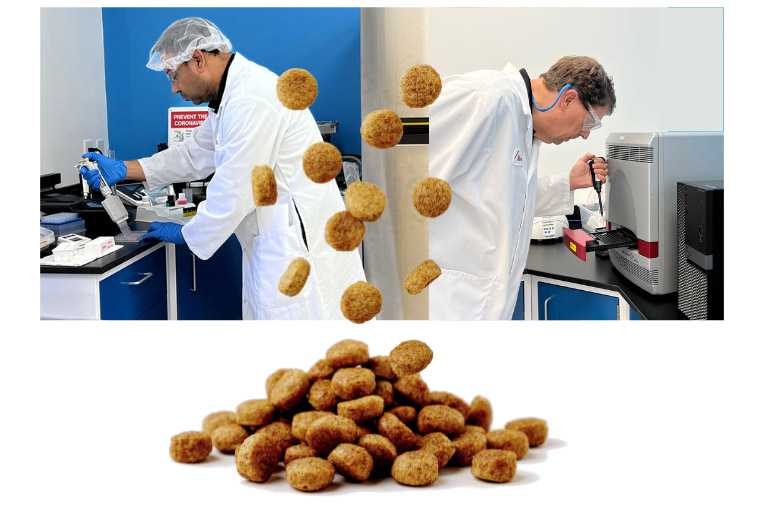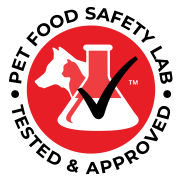What We Test For

At Pet Food Safety Lab™ (PFSL), every batch of food is tested for quality and safety to give you peace of mind that your food is safe to feed your pet. We rigorously test each batch of pet food before it is released. The lab possesses chemical, physical, and microbiological testing capabilities to meet the inspection needs of your product.
 Routine microbiological testing includes salmonella, E. coli, and listeria with sample enrichment and PCR (polymerase chain reaction) testing capability.
Routine microbiological testing includes salmonella, E. coli, and listeria with sample enrichment and PCR (polymerase chain reaction) testing capability.
Furthermore, our lab is equipped with a state-of-the-art LCMS (liquid chromatography-mass spectrophotometer) that is capable of detecting materials or contaminants at sub-ppm levels. We can test for melamine, cyanuric acid, B vitamins, vitamin D, or any other analyte you need.
Other non-instrumental methods include mycotoxins by ELISA, water activity, hardness, pH, density, and Petrifilm™ environmental evaluations.
The following tests below are used to evaluate the quality and safety of the food you feed your pet. Click on the “+” for details on each test.
Aflatoxin is a chemical (mycotoxin) produced by a class of fungus (mold) called aspergillus. Molds can form in the agricultural supply chain process when a crop such as wheat, soybean, or walnuts is allowed to contain too much moisture, and mold grows upon standing. Unfortunately, these molds can be very common, and great care must be taken to make sure these farm products are free of aflatoxin.
Fumonisin is another mycotoxin that is produced by a mold (genus Fusarium). Poor farm processing methods can also be at the root cause of Fumonisin issues, which most affect grain/cereal type crops. Acute toxicity of this mycotoxin are fairly low, but, in some cases, infection can be quite serious.
DON (deoxynivalenol) is a mycotoxin that is a metabolic waste of the mold species Fusarium. As the name implies, it can cause violent vomiting episodes. Fusarium is found in many common grains and is naturally occurring.
Ochratoxin is actually a family of mycotoxins, the most prevalent of which is Ochratoxin A. It is also produced by mold species such as Aspergillus and Penicillium, thriving is wet, moist environments. Contaminated grains and pork are most often the sources, but Ochratoxin can also be found in grapes and coffee.
The mycotoxin Zearalenone is produced by the mold species Fusarium and Gibberella. This mycotoxin can bind to estrogen receptors, leading to infertility and abortion. Common crops such as maize, barley, oats, wheat, and rice can harbor these molds if not properly handled in the supply chain.
Cyanuric Acid is a common chemical found in pool chemicals, bleaches, disinfectants, and herbicides. It is also a side-product of melamine production and can be found in unpurified melamine powder. It forms a highly insoluble chemical called melamine cyanurate, which is also a component of the kidney crystallization issue seen in the pet food recalls from 2007.
A chemical that is used in the production of many household plastic items. Melamine is not a food ingredient nor intended to be ingested. If melamine was present in pet food, a protein assay would read as having a higher protein value than is actually present. Unfortunately, some unethical food suppliers used this chemical to “boost” protein levels in raw materials, resulting in a significant industry-wide pet food recall crisis in 2007. Melamine can crystallize in a pet’s kidneys, causing severe illness and death. While the pet food industry appears to have become more stringent with raw material suppliers, our lab performs testing to detect melamine.
coli(Escherichia coli) is a gram-negative, rod-shaped bacterium that is commonly found in animal intestines. While most E. coli forms are harmless, shiga toxin-producing variants can cause severe illness and sometimes death. E. coli finds its way into the food supply through fecal matter contamination of raw materials or processing plants.
Salmonella spp. (species) is a group of gram-negative bacteria from the family Enterobacteriaceae. Most infections are caused by contaminated foods that have been exposed to animal or human fecal material. Symptoms include diarrhea, cramping, nausea, and bloody stool.

